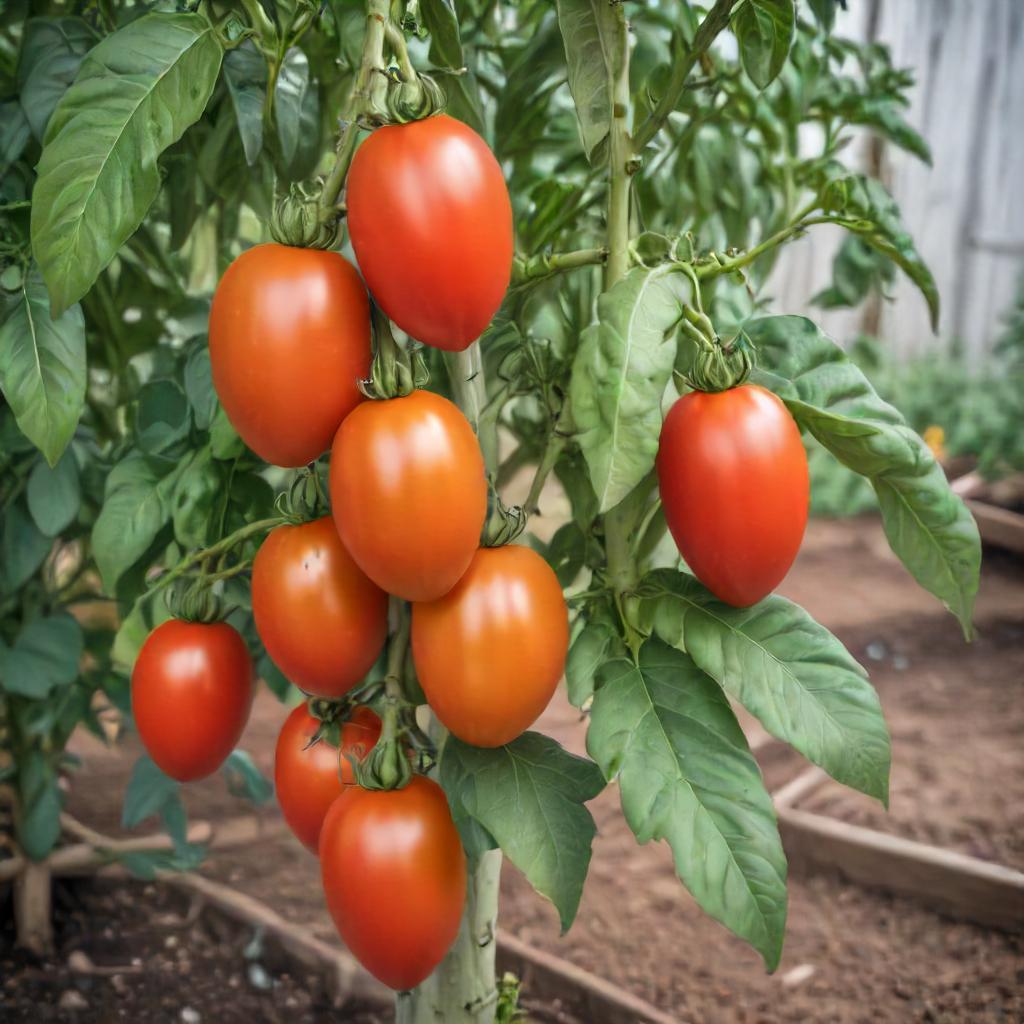- Hardiness Zone: 3-10 Annual
- Determinate
Seed Depth: 1/4 inch
Seed Spacing: 24–36 inches
Row Spacing: 36–48 inches
Sunlight: Full sun
Days to Sprout: 7–14 days
Days to Maturity: 75–85 days
Growth Habit: Determinate Bushy
Sunlight: Requires full sun, at least 6–8 hours daily, for optimal fruit production.
Soil Type: Thrives in well-drained, fertile soil with a pH of 6.0–6.8.
When to Plant: Start seeds indoors 6–8 weeks before the last frost and transplant outdoors once nighttime temperatures are above 55°F.
Direct Sowing: Not recommended; start indoors for stronger, healthier seedlings.
Indoor Sowing: Sow seeds 1/4 inch deep in seed trays and keep soil warm (70–80°F) for consistent germination.
Succession Planting: Space out plantings for a continuous harvest throughout the growing season.
Watering: Keep the soil consistently moist but not waterlogged. Water tomatoes regularly, especially during dry periods. Water at the base of the plant to avoid wetting the foliage, which can lead to disease.
Fertilization: Tomatoes are heavy feeders. Apply a balanced fertilizer or compost at planting time. Side-dress with compost or a balanced fertilizer every 4-6 weeks during the growing season. Reduce nitrogen levels as fruits begin to form to encourage fruit development over foliage growth.
Mulching and Weeding: Apply a layer of mulch around the plants to retain soil moisture, suppress weeds, and keep the soil temperature consistent. Hand-pull weeds carefully to avoid disturbing the shallow roots of the tomatoes.
Staking and Pruning: Rio Grande tomatoes are determinate, meaning they grow to a set height and produce fruit all at once. Staking or caging can help support the plants and keep the fruit off the ground. Pruning is generally not necessary for determinate varieties.
Pest and Disease Management: Tomatoes can be susceptible to pests such as aphids, tomato hornworms, and whiteflies. Use organic pest control methods like neem oil, insecticidal soap, or hand-picking to manage infestations. Practice crop rotation and ensure good air circulation to prevent fungal diseases like blight and powdery mildew.
When to Harvest: Rio Grande Paste Tomatoes are typically ready to harvest 70-80 days after transplanting. Harvest when the fruits are fully red and firm to the touch.
How to Harvest: Use a sharp knife or pruning shears to cut the fruit from the plant, leaving a short stem attached. Handle the fruits gently to avoid bruising.
Storing Fresh Tomatoes: Freshly harvested tomatoes can be stored at room temperature for a few days or in the refrigerator for up to a week. For longer storage, tomatoes can be canned, frozen, or dried.
Why You’ll Love It
Rio Grande Paste Tomatoes are known for their excellent texture, disease resistance, and ability to thrive in hot, dry conditions. These determinate plants yield meaty, plum-shaped tomatoes with fewer seeds and lower moisture — ideal for making thick sauces, salsa, and paste. They hold well on the vine and are great for preserving, roasting, or cooking down into rich tomato dishes.
Plant Characteristics
Height: 24–36 inches
Growth Habit: Determinate (bush type)
Fruit Type: Oval to pear-shaped red paste tomatoes, 4–6 ounces
Days to Maturity: 75–80 days
Hardiness: Warm-season annual
Flavor and Culinary Uses
Flavor: Mild, sweet, and rich with low moisture content
Culinary Uses: Ideal for tomato paste, sauces, salsa, roasting, and canning. Holds shape and flavor well in cooking.
Companion Planting Tips
Good Companions: Basil, onions, garlic, marigolds, and carrots
Avoid Planting Near: Corn or potatoes, which may compete or share pests
Bonus Benefit: Fruits are crack-resistant and store well after harvest, making them a top pick for preserving
Common Issues and Solutions
Slow Ripening: Ensure full sun exposure and good airflow around plants
Blossom End Rot: Avoid uneven watering and maintain calcium levels in the soil
Fungal Issues: Water at the base, space plants well, and mulch to prevent soil splash
Seeds Per Packet
| 250mg | Approximately 90 |
| 500mg | Approximately 180 |
| 1g | Approximately 360 |
| 2g | Approximately 720 |
Why You’ll Love It
Rio Grande Paste Tomatoes are known for their excellent texture, disease resistance, and ability to thrive in hot, dry conditions. These determinate plants yield meaty, plum-shaped tomatoes with fewer seeds and lower moisture — ideal for making thick sauces, salsa, and paste. They hold well on the vine and are great for preserving, roasting, or cooking down into rich tomato dishes.
Plant Characteristics
Height: 24–36 inches
Growth Habit: Determinate (bush type)
Fruit Type: Oval to pear-shaped red paste tomatoes, 4–6 ounces
Days to Maturity: 75–80 days
Hardiness: Warm-season annual
Flavor and Culinary Uses
Flavor: Mild, sweet, and rich with low moisture content
Culinary Uses: Ideal for tomato paste, sauces, salsa, roasting, and canning. Holds shape and flavor well in cooking.
Companion Planting Tips
Good Companions: Basil, onions, garlic, marigolds, and carrots
Avoid Planting Near: Corn or potatoes, which may compete or share pests
Bonus Benefit: Fruits are crack-resistant and store well after harvest, making them a top pick for preserving
Common Issues and Solutions
Slow Ripening: Ensure full sun exposure and good airflow around plants
Blossom End Rot: Avoid uneven watering and maintain calcium levels in the soil
Fungal Issues: Water at the base, space plants well, and mulch to prevent soil splash
Seeds Per Packet
| 250mg | Approximately 90 |
| 500mg | Approximately 180 |
| 1g | Approximately 360 |
| 2g | Approximately 720 |






Share and get 15% off!
Simply share this product on one of the following social networks and you will unlock 15% off!